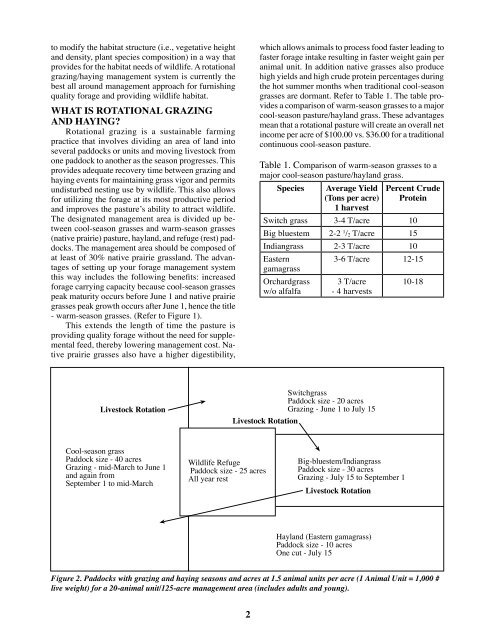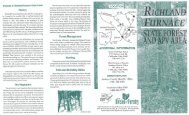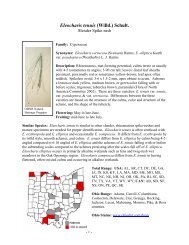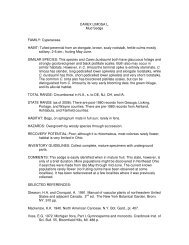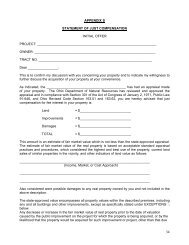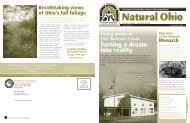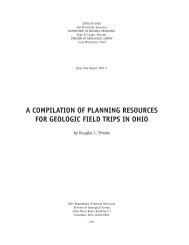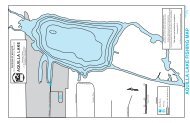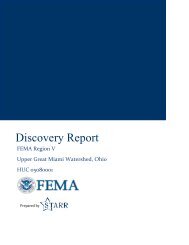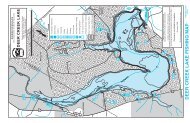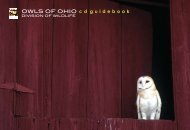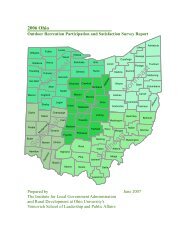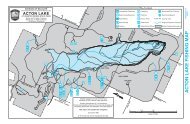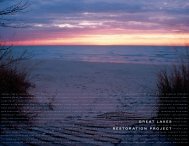Pasture/Hayland Management for Wildlife and Livestock
Pasture/Hayland Management for Wildlife and Livestock
Pasture/Hayland Management for Wildlife and Livestock
Create successful ePaper yourself
Turn your PDF publications into a flip-book with our unique Google optimized e-Paper software.
to modify the habitat structure (i.e., vegetative height<br />
<strong>and</strong> density, plant species composition) in a way that<br />
provides <strong>for</strong> the habitat needs of wildlife. A rotational<br />
grazing/haying management system is currently the<br />
best all around management approach <strong>for</strong> furnishing<br />
quality <strong>for</strong>age <strong>and</strong> providing wildlife habitat.<br />
What is rotational grazing<br />
<strong>and</strong> haying<br />
Rotational grazing is a sustainable farming<br />
practice that involves dividing an area of l<strong>and</strong> into<br />
several paddocks or units <strong>and</strong> moving livestock from<br />
one paddock to another as the season progresses. This<br />
provides adequate recovery time between grazing <strong>and</strong><br />
haying events <strong>for</strong> maintaining grass vigor <strong>and</strong> permits<br />
undisturbed nesting use by wildlife. This also allows<br />
<strong>for</strong> utilizing the <strong>for</strong>age at its most productive period<br />
<strong>and</strong> improves the pasture’s ability to attract wildlife.<br />
The designated management area is divided up between<br />
cool-season grasses <strong>and</strong> warm-season grasses<br />
(native prairie) pasture, hayl<strong>and</strong>, <strong>and</strong> refuge (rest) paddocks.<br />
The management area should be composed of<br />
at least of 30% native prairie grassl<strong>and</strong>. The advantages<br />
of setting up your <strong>for</strong>age management system<br />
this way includes the following benefits: increased<br />
<strong>for</strong>age carrying capacity because cool-season grasses<br />
peak maturity occurs be<strong>for</strong>e June 1 <strong>and</strong> native prairie<br />
grasses peak growth occurs after June 1, hence the title<br />
- warm-season grasses. (Refer to Figure 1).<br />
This extends the length of time the pasture is<br />
providing quality <strong>for</strong>age without the need <strong>for</strong> supplemental<br />
feed, thereby lowering management cost. Native<br />
prairie grasses also have a higher digestibility,<br />
which allows animals to process food faster leading to<br />
faster <strong>for</strong>age intake resulting in faster weight gain per<br />
animal unit. In addition native grasses also produce<br />
high yields <strong>and</strong> high crude protein percentages during<br />
the hot summer months when traditional cool-season<br />
grasses are dormant. Refer to Table 1. The table provides<br />
a comparison of warm-season grasses to a major<br />
cool-season pasture/hayl<strong>and</strong> grass. These advantages<br />
mean that a rotational pasture will create an overall net<br />
income per acre of $100.00 vs. $36.00 <strong>for</strong> a traditional<br />
continuous cool-season pasture.<br />
Table 1. Comparison of warm-season grasses to a<br />
major cool-season pasture/hayl<strong>and</strong> grass.<br />
Species<br />
Average Yield<br />
(Tons per acre)<br />
1 harvest<br />
Percent Crude<br />
Protein<br />
Switch grass 3-4 T/acre 10<br />
Big bluestem 2-2 1 /2 T/acre 15<br />
Indiangrass 2-3 T/acre 10<br />
Eastern<br />
gamagrass<br />
Orchardgrass<br />
w/o alfalfa<br />
3-6 T/acre 12-15<br />
3 T/acre<br />
- 4 harvests<br />
10-18<br />
livestock rotation<br />
livestock rotation<br />
Switchgrass<br />
Paddock size - 20 acres<br />
Grazing - June 1 to July 15<br />
Cool-season grass<br />
Paddock size - 40 acres<br />
Grazing - mid-March to June 1<br />
<strong>and</strong> again from<br />
September 1 to mid-March<br />
<strong>Wildlife</strong> Refuge<br />
Paddock size - 25 acres<br />
All year rest<br />
Big-bluestem/Indiangrass<br />
Paddock size - 30 acres<br />
Grazing - July 15 to September 1<br />
livestock rotation<br />
<strong>Hayl<strong>and</strong></strong> (Eastern gamagrass)<br />
Paddock size - 10 acres<br />
One cut - July 15<br />
Figure 2. Paddocks with grazing <strong>and</strong> haying seasons <strong>and</strong> acres at 1.5 animal units per acre (1 Animal Unit = 1,000 #<br />
live weight) <strong>for</strong> a 20-animal unit/125-acre management area (includes adults <strong>and</strong> young).


